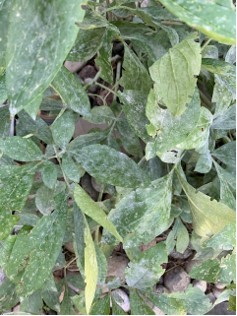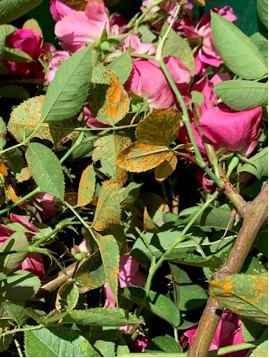Fall Cleanup: Remove Disease and Support Beneficial Wildlife
- 2023-09-04
- By mkirk
- Posted in Horticulture, The Garden Buzz
By Lucinda Greene, Colorado Master Gardener
We have experienced an unusual growing season in the Denver metro area with higher-than-normal precipitation, damaging hail, and hot daytime temperatures. Before too long, winter weather will be coming along. How do you care for your garden to prepare for the change in seasons? While many gardeners clean up perennial beds shortly after the first freeze of the season, experts now agree that keeping some plant material untrimmed can be beneficial for wildlife and insects who depend on dried and dead plant matter for nesting and food sources.
However, one thing you don’t want to do is leave any remnants of plant disease that can overwinter in your garden. This only creates problems for the following growing season. With proper environmental conditions, disease pathogens can multiply and cause damage to your plants. By cleaning up in the fall, you reduce this risk. Proper plant spacing and removing dead foliage can improve air circulation. Fall is a good time to divide perennials to provide adequate spacing if plants are too crowded and showing signs of disease.


Left, Powdery mildew on peony; Right, Rose rust. Photos: Lucinda Greene
Powdery mildew, black spot, fire blight and rust are common garden diseases that can remain in the garden on plant debris. Powdery mildew is a fungal disease that creates a white coating on plant leaves. This disease affects many perennials and roses along with cucurbits like cucumbers, squash, and pumpkins. Because the spores can overwinter, plants may become re-infected the following season. Black spot is a fungal disease that affects roses. Black spots develop on leaves. The fungus can remain on fallen leaves and infected canes through the winter. Fire blight is a bacterial disease that affects trees in the rose family, such as apple and pear trees. It causes wilting and blackening of shoots that curl into a characteristic shepherd’s crook. Fire blight bacteria can spread from infected branches and cankers. Rust is a group of fungal diseases that cause orange or yellow pustules to form on leaves and stems. Some rust fungi may require two plant hosts.
Use good judgment when cleaning up your garden this fall. Keep healthy plant material to serve beneficial insects and wildlife and remove all plant debris that may spread disease.
Horticulture Resources
- Garden Buzz Archives
- CSU Extension Resources
- Colorado Master Gardener Program
- Foothills to Plains Native Plant Master Program
- Native Bee Watch Community Science Program
- The Co-Hort Blog
- PlantTalk Colorado
- Soil Testing
- Plant Select
- Emerald Ash Borer
- Japanese Beetle
- Colorado State Forest Service
- Ask an Expert


